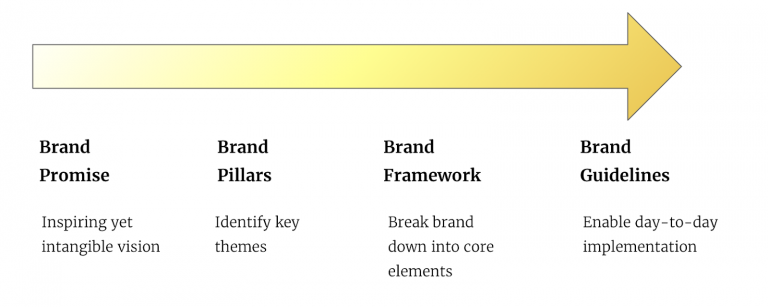
The Last Mile of Branding in Higher Ed — Activation and Implementation
You've built the foundation of your branding platform. Now it's time to focus on the "last mile" portion of the process: activation and implementation.
I am hopeful that we are entering an era when “brand” will no longer be a dirty word in higher education. Similarly, “business goals,” “product,” and “marketing”... hey, a girl can dream.
But in a time when institutions are competing intensely for students, investing hefty sums in the quest for differentiation, and in some cases simply trying to stay open, the idea of colleges and universities having brands — with a strong business need to consistently refine and express them — can no longer be discounted. Coke versus Pepsi, but make it the ROI of a liberal arts education.
I love brand work in higher ed. It brings out my inner journalist and my inner poet — the opportunity to dig deeply into an institution’s identity and figure out the best, most distinctive way to express that identity. When done well, a branding platform captures the essence of a school in a way that feels unique, distinguishing, and compelling — it should say, “we’re not for everybody, but if [ gestures wildly at brand ] resonates with you, then we’re your kind of place.”
The challenge, however, is taking that unique, distinguishing, and compelling platform and putting it to work. Inspirational position statements, intriguing personality traits, and thoughtfully articulated frameworks may feel true and relevant. But the distance between that presentation deck and a viewbook, a homepage narrative — or heck, an Instagram post — can feel vast.
Understanding “The Last Mile” of Branding
Back when I worked at Tufts University, I interviewed an expert on humanitarian response to disasters and other crises, and he introduced me to the concept of “the last mile.” Often employed in the context of the supply chain, the “last mile” is the final leg of a journey, whether it means delivering humanitarian relief to individuals in need or a parcel completing its journey to your doorstep. The last mile, for a variety of reasons, can often be the most complex and resource-intensive stage of the process. But it’s also the most crucial.
This is true with branding, as well. Most branding platforms are painstakingly researched and informed by a sense of communications goals and target audiences. They may include sample topics for certain messages or attributes. But what they lack is a conduit between your high-level brand identity and the vessels in which that brand is going to go to work on behalf of the institution.
Imagine that your brand is gasoline — it’s got all the ingredients to get you going — your website, your newsletter, your brochure, whatever it may be! But is the gas the right type of gas for your car? Do you even know where the gas station is? Do you know which side of your car the gas tank is on? Will the nozzle fit? And have you seen the price of gasoline lately?!
Roadmap to Tactical Brand Activation
There are a lot of factors that stand between your readiness to bring your brand out into the world and actually being able to — that’s brand activation. Consider this spectrum of brand activation:

To be effective, every brand needs a guide — a roadmap, a manual, a clear and usable set of guidelines that gives us confidence in how to get our vehicle gassed up and ready to go. Since we operate mainly in the digital space, we think about this in the context of content strategy.
Here are some of the main areas you will want to be certain to address when thinking through how to fully and meaningfully activate your brand for digital expression:
Organizational Structure and Resources
The best brand platform — no matter how aligned, compelling, and evocative — will fail if the organization charged with its execution is not prepared for the task. Do you have enough people to do the work? Do you have the right kinds of people — writers, photographers, videographers, etc.? Is there funding for freelancers, photo shoots, or other support? Do you have an effective process by which these people come together to create impactful brand communications?
Any institution undertaking a branding exercise should correspondingly take a close look at its marketing and communications function and determine if it is aligned to the present-day expectations for effective brand expression. Identify any potential blockers for effective and consistent generating brand-aligned communications, and address them before you go too far down the branding road. If that is not doable, then temper your branding ambitions to the realities of your organization.
Brand Governance
The brand may not need to be “owned,” but it must be led. From that leadership seat, the brand must be socialized and seeded across the organization, and its rationale must be transparent. What of those brand leadership responsibilities are shared across the organization, if any?
A key responsibility of that leadership is brand training, which cannot be overlooked as a critical aspect of brand activation. Training modules can provide guidance on written and visual brand expression, as well as corresponding messaging and communications strategies. It must take a multiplatform approach, be offered on an ongoing basis, and be revised as new communications opportunities or brand opportunities emerge.
Another responsibility is aligning the brand to day-to-day decision-making. Is someone buying a cool new virtual tour app? Hiring a snazzy SEO vendor? How will you ensure that those efforts, funded by institutional resources, will appropriately take into consideration the brand that is the working expression of institutional priority and identity? Can that be a stipulation for relevant contracts, particularly those made by outlying units?
Also, how are new project requests — microsites, brochures, etc. — being considered in the context of the brand? Project briefs and triage processes should be structured to ensure new projects are appropriately aligned to the institutional brand and strategic plan, with relevant goals clearly defined. The rigor of this process usually entails some degree of cultural change, particularly in environments used to more casual arrangements. But some degree of rigor is necessary to uphold the integrity of the brand.
Editorial Strategy
Your brand platform may already provide some light topical guidance as to what aspects of the campus experience relate to which aspects of the brand. But folding this guidance into a more comprehensive editorial strategy takes the work to the next level.
A fundamental part of this is your editorial process — integrating brand (and even strategic plan) levers into day-to-day editorial decision-making. Think about what roles you need in your editorial process, how decisions get made, and how you track and plan your brand efforts. An editorial calendar, with corresponding opportunities for the team to meet and plan or discuss ideas, will be key to helping hold you accountable to your brand activation objectives.
Another is your distribution strategy. While it’s an amazing movie, “Everything Everywhere All at Once” is not an effective brand communications strategy. Think about targeting the right brand stories to the right audience at the right time. What segments are we reaching? On which platforms?
Lastly, consider the raw material of the brand — the stories and data points swirling through the air at any given institution. Do you have reliable, consistent access to this information? Can your brand help you create criteria to determine which stories to tell and how to tell them?
Diversity, Equity, and Inclusion
How closely was your brand platform considered in the context of your institution’s priorities around diversity, equity, and inclusion? If your brand builds off notable aspects of your institutional history, are there any problematic factors that need to be addressed or reconciled?
As many institutions are currently taking on the important work of being reflective about how they cultivate inclusive communities and create a more diverse campus environment, any brand work should be considered closely alongside those efforts to be sure they are working hand in hand.
Brand Style Guidelines
The aspirational direction laid out by brand personality attributes must be translated into actionable brand guidelines that are made accessible by all relevant campus communicators. This means creating a style guide that takes into account language and visual content considerations, tone considerations for specific contexts (e.g. campus visit vs. financial aid requirements).
A style guide is also a great opportunity to provide sample content (photos, copy, etc.) that can help direct content creators to what is (and isn’t) brand-appropriate.
Your visual brand elements are also a consideration here. Are the brand colors accessible? Do graphical elements work in both digital and print contexts? Heck, these typefaces are nice, but are they in budget for campus-wide usage — and if not, should we define alternatives?
Validating the Brand Strategy with Data
We should be looking for ongoing opportunities to confirm the effectiveness and relevance of the brand platform. One way to do this is message testing with key audiences and segments therein. Results may guide refinement to the platform or, more likely, refinement to your activation strategy — adding platforms, adjusting tone, word or imagery choice.
Analytics can also indicate the success of your brand execution. Define KPIs as part of your brand activation strategy — email open rates, engagement with brand stories, rate of conversion for those who interacted with branded content, etc.
Prioritize engagement and conversion (you are thinking about how to leverage your brand to motivate key conversions, right?) over volume and reach as relevant metrics — remember, we are putting the brand to work, and data helps us determine how effective that work actually is.